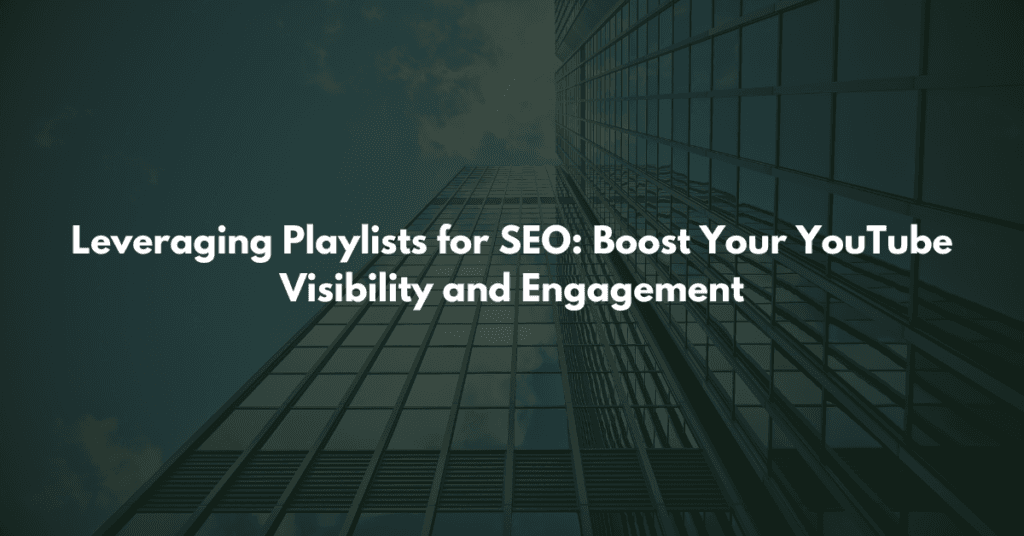Playlists on YouTube are more than just a way to organize your videos—they are a powerful tool for enhancing your SEO and growing your channel. By grouping videos strategically and optimizing playlists for discovery, you can improve your channel’s visibility and boost audience engagement. This guide will walk you through actionable tips to leverage playlists for SEO, ensuring your content ranks higher and keeps viewers hooked.
Why Playlists Matter in YouTube SEO
Playlists serve multiple purposes, making them an essential strategy for YouTube creators.
Enhancing Visibility
YouTube’s algorithm favors content that keeps viewers on the platform longer. Playlists encourage viewers to watch multiple videos consecutively, increasing session watch time—a crucial ranking factor.
Improving User Experience
Organized playlists help viewers find related content with ease. For instance, a playlist titled “Beginner’s Guide to Cooking” groups all beginner-friendly recipes, making it convenient for viewers and signaling relevance to YouTube’s algorithm.
Building Authority
By grouping content around specific topics, playlists establish your channel as a go-to resource in your niche, whether it’s tech tutorials, fitness tips, or travel vlogs.
Grouping Videos by Topic and Keywords in Playlists
A well-structured playlist begins with thoughtful planning.
The Importance of Relevance
Grouping videos by topic ensures viewers remain engaged. For example, if you run a fitness channel, you might create playlists like “15-Minute Workouts” or “Yoga for Beginners.”
Incorporating Keywords
When organizing your playlists, identify high-performing keywords related to your niche. Use tools like YouTube Autocomplete or Google Keyword Planner to find terms viewers frequently search for. Ensure these keywords align with your video topics and titles within the playlist.
Analyzing Data to Refine Playlists
Use YouTube Analytics to understand which topics resonate most with your audience. Identify videos with high watch time or engagement and include them in relevant playlists to boost their visibility.
Optimizing Playlist Titles and Descriptions for Better Discovery
An optimized playlist title and description can significantly improve its discoverability on YouTube.
Crafting Keyword-Rich Titles
Your playlist title should be clear, concise, and keyword-focused. Instead of generic titles like “Videos I Like,” use something actionable, like “How to Start a Garden: Tips and Tricks.”
Writing Descriptions That Convert
Descriptions offer an opportunity to explain the playlist’s value while incorporating keywords naturally. For instance:
“This playlist covers everything you need to know about starting a garden, including soil preparation, planting techniques, and seasonal tips.”
Example of a Fully Optimized Playlist
- Title: “Mastering Video Editing: Tips for Beginners and Pros”
- Description: “Learn video editing techniques with this comprehensive playlist. From basic editing tools to advanced effects, these tutorials will help you create professional-quality videos.”
Leveraging Playlists for Audience Retention and Engagement
Playlists are not just about organization; they’re a tool for keeping viewers engaged.
Creating a Logical Sequence
Order your videos strategically to maintain viewer interest. For example, start with introductory videos, move to detailed tutorials, and end with advanced techniques.
Using End Screens and Cards
Promote your playlists using end screens and cards. For example, after a video on baking a cake, link to a playlist like “Baking Basics.”
Engaging Viewers to Subscribe
Encourage viewers to subscribe at the end of a playlist. A simple call-to-action, such as, “Enjoyed these tutorials? Subscribe for more content like this!” can go a long way.
Sharing and Promoting Playlists for Maximum Reach
Your playlists won’t gain traction if they aren’t promoted effectively.
Embedding Playlists
Embed your playlists on your website or blog to drive traffic. For example, a travel blogger could embed a “Top Destinations in Europe” playlist in a related blog post.
Promoting on Social Media
Share your playlists on platforms like Instagram, Twitter, and Facebook. Use compelling captions to attract clicks, such as:
“Planning your next trip? Check out our playlist for travel inspiration!”
Collaborating with Other Creators
Partnering with creators in your niche can introduce your playlists to a broader audience. Collaborative playlists or cross-promotion are excellent strategies.
Measuring the Impact of Playlists on SEO
Regularly monitor your playlist performance to refine your strategy.
Key Metrics to Track
- Watch Time: Are viewers completing the playlist?
- Engagement: Are viewers liking, sharing, or commenting on playlist videos?
- Traffic Sources: Where are viewers finding your playlists?
Using Insights to Improve
If certain playlists underperform, tweak the titles, descriptions, or sequence. Test changes and measure the results to optimize for better outcomes.
Conclusion
Leveraging playlists for SEO is a powerful way to boost your YouTube channel’s visibility and engagement. By grouping videos by topic, optimizing playlist descriptions, and sharing strategically, you can maximize your reach and watch time. Start implementing these strategies today, and watch your channel grow as you harness the full potential of playlists.
FAQs
1. How do playlists improve YouTube SEO?
Playlists increase session watch time and make it easier for viewers to consume related content, signaling relevance to YouTube’s algorithm.
2. Can I rank playlists in YouTube search results?
Yes, with optimized titles and descriptions, playlists can appear in search results and attract viewers searching for specific topics.
3. How many videos should a playlist contain?
Aim for 5–15 videos. Too few may lack depth, while too many might overwhelm viewers.
4. Should I include the same video in multiple playlists?
Yes, if the video is relevant to different topics, including it in multiple playlists can expand its reach.
5. How often should I update my playlists?
Review your playlists quarterly to ensure they remain relevant and aligned with audience preferences.



